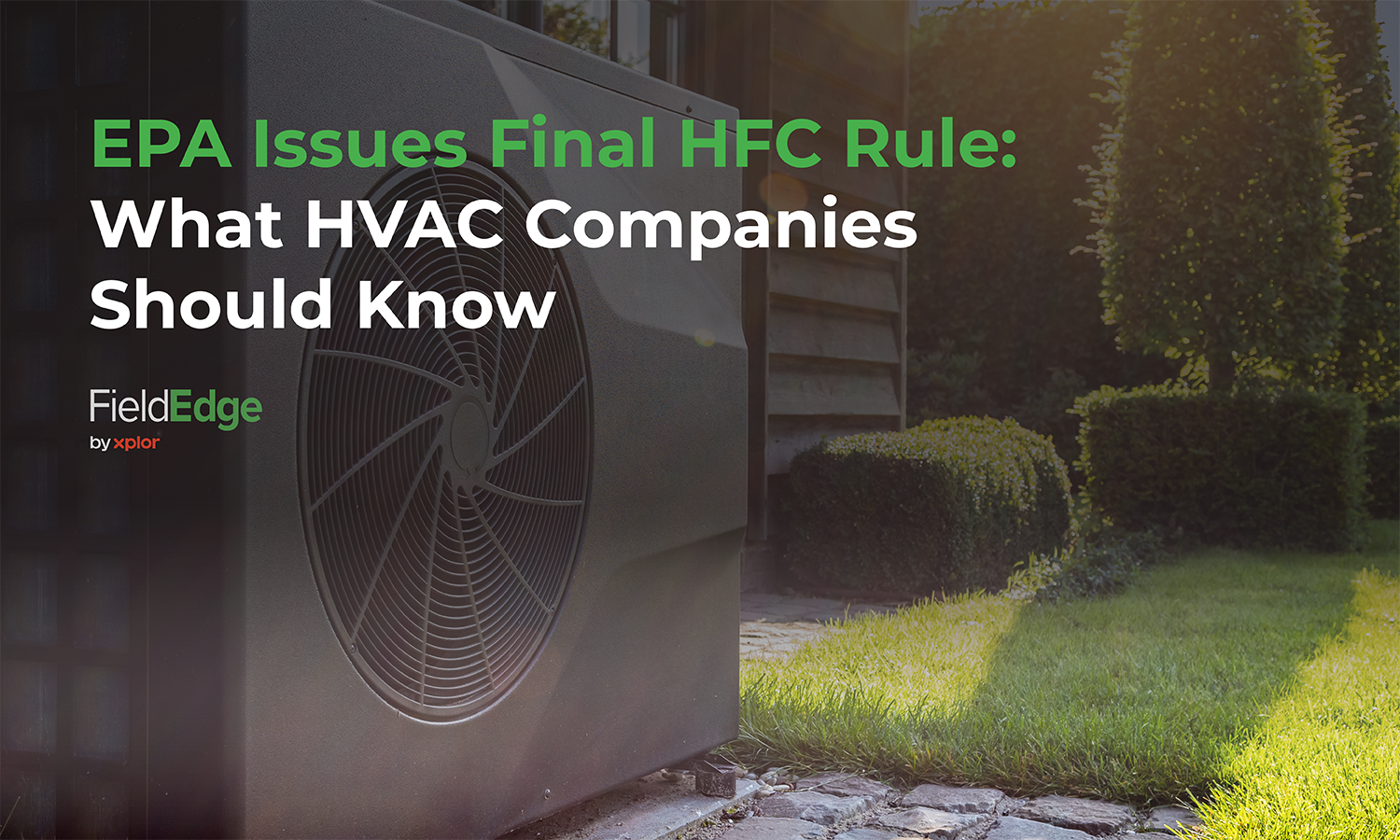On September 23, 2024, the Environmental Protection Agency (EPA) issued its final ruling on hydrofluorocarbons (HFCs), a decision that will significantly impact the HVAC industry. This HFC rule follows two previous rules as part of the AIM Act.
As part of ongoing efforts to combat climate change, the HFC rule mandates a phased reduction in the production and use of these harmful greenhouse gasses. For HVAC companies, this regulation represents both a challenge and an opportunity to adapt and thrive.
In this blog, we’ll explore:
- What the EPA’s final HFC rule entails
- How the HFC phaseout will affect HVAC companies
- Alternatives to HFCs
- Best practices for compliance and growth opportunities in the changing landscape
What Is the EPA’s Final HFC Rule?
The HFC rule is a critical part of the U.S. government’s plan to significantly reduce the use of hydrofluorocarbons, which are powerful greenhouse gasses used primarily in refrigeration, air conditioning and insulation. While HFCs do not deplete the ozone layer, they contribute heavily to climate change—being thousands of times more effective at trapping heat in the atmosphere than carbon dioxide.
This final rule, issued in September 2024, follows earlier regulations aimed at gradually reducing HFC consumption and production. By 2036, the goal is to cut HFC usage by 85%, aligning the U.S. with international agreements such as the Kigali Amendment to the Montreal Protocol.
Timeline for Compliance: What to Expect
For HVAC businesses, the HFC rule will unfold in a series of phases, allowing for a gradual reduction of HFC production and consumption. Here’s a breakdown of the compliance timeline:
- 2024-2025: The first stage of reductions begins, with caps placed on the import and production of HFCs. HVAC companies will see limits on the availability of certain refrigerants.
- 2025-2029: Further reductions in HFC availability. Companies will need to transition toward alternatives for installations and service calls involving refrigeration and air conditioning systems.
- 2030-2036: By 2036, the EPA aims to achieve an 85% reduction in HFCs. Companies will be required to use alternative refrigerants and failing to comply may result in penalties.
The phaseout is structured to give HVAC businesses time to adapt, but the sooner companies begin to plan, the better positioned they’ll be to avoid disruptions and remain competitive.
Impact on HVAC Companies
The HFC rule will have widespread implications for HVAC businesses of all sizes. Here’s how it could impact your operations:
- Cost and Availability of Refrigerants: As HFCs become more scarce, their prices are expected to rise. This could lead to increased costs for HVAC companies using HFC-based refrigerants like R-410A and R-134a in air conditioning and refrigeration systems.
- Need for Technician Training: As alternatives to HFCs emerge, HVAC technicians will need specialized training to handle new refrigerants, such as hydrofluoroolefins (HFOs) or natural refrigerants, like ammonia or carbon dioxide. Ensuring your team is up-to-date with certifications and skills is essential.
- Retrofitting Equipment: For existing systems that rely on HFCs, retrofitting may become necessary. Retrofitting existing units to work with alternative refrigerants can help HVAC companies extend the life of older systems while staying compliant with the HFC rule.
- Opportunity for Growth: Companies that proactively adopt alternative refrigerants and market their eco-friendly services may gain a competitive advantage. HVAC businesses that can offer solutions compliant with the new regulations will likely appeal to environmentally conscious customers.
Alternative Refrigerants to Consider
As the HFC phaseout progresses, HVAC businesses must explore environmentally friendly alternatives to keep their systems in line with the HFC rule. Here are a few key options:
- Hydrofluoroolefins (HFOs): HFOs have a much lower global warming potential (GWP) than HFCs and are often used in air conditioning and refrigeration systems as a direct replacement for HFCs.
- Carbon Dioxide (CO2): CO2 is an effective natural refrigerant with minimal impact on the environment. It is often used in commercial refrigeration and is gaining popularity in industrial systems.
- Ammonia (NH3): Ammonia has been used as a refrigerant for over a century and is particularly effective in large-scale refrigeration systems. However, it requires careful handling due to its toxicity.
- Propane (R-290): Propane is another natural refrigerant with a low GWP, making it an attractive alternative for small HVAC and refrigeration units. Its flammability, however, requires strict safety measures.
Transitioning to these alternatives will require new training and possibly retrofitting equipment, but it’s essential to remain compliant with the HFC rule.
Best Practices for Compliance
To remain compliant with the EPA’s HFC rule, HVAC companies should begin preparing now. Here are some best practices to consider:
- Audit Current Equipment: Review all systems currently using HFC refrigerants and assess which ones may need to be retrofitted or replaced.
- Train Technicians: Provide training for your technicians to handle alternative refrigerants safely and effectively. Ensuring your team has the necessary certifications will put your business ahead of the curve.
- Communicate with Clients: Educate your customers about the HFC phaseout and what it means for their HVAC systems. Offering environmentally friendly alternatives can help you upsell services while ensuring clients are compliant.
- Stay Informed: As the HFC rule evolves, staying up-to-date on any new regulations or changes is key. Monitor EPA updates and industry publications to keep your business informed.
Growth Opportunities for HVAC Companies
While the HFC rule may seem like a challenge, it also opens the door to new opportunities for HVAC businesses. By offering eco-friendly alternatives, businesses can market themselves as environmentally responsible and attract clients who prioritize sustainability.
Moreover, by being proactive in compliance and training, HVAC companies can position themselves as leaders in their field. Companies that adopt the new technologies and refrigerants quickly may even find themselves ahead of competitors who are slower to adapt.
Stay Up To Date with HFC Regulations
The EPA’s final HFC rule is a landmark regulation that will shape the future of the HVAC industry. As HVAC companies prepare for the phased reduction of HFCs, it’s essential to understand the timeline for compliance, explore alternative refrigerants and implement best practices for retrofitting equipment.
Here are a few takeaways:
- Understand the impact of the EPA’s HFC rule on your business
- Explore and adopt alternative refrigerants to stay compliant
- Train your technicians to handle new refrigerants and offer retrofitting services
- Communicate with clients about the benefits of eco-friendly systems
- Leverage growth opportunities by positioning your company as a leader in sustainability
By staying ahead of the curve, HVAC companies can turn the challenge of the HFC phaseout into an opportunity for growth and innovation.
Related: EPA Introduces Rules For HFC Refrigerant Management and Technology Transitions



